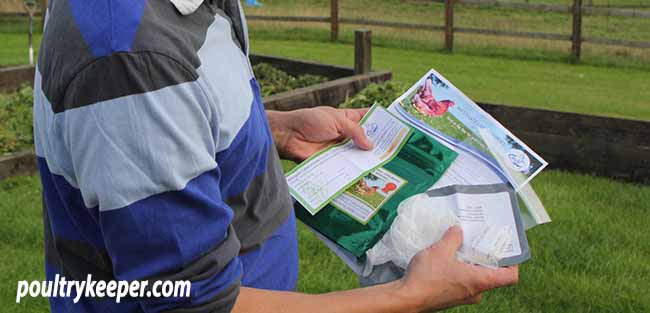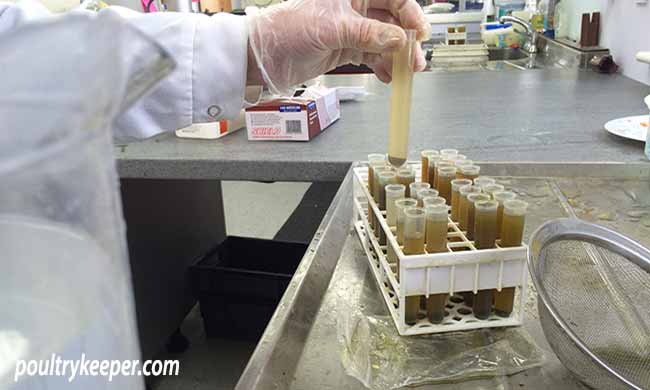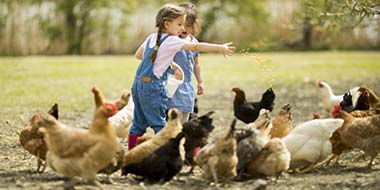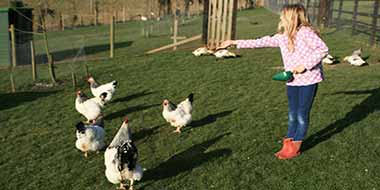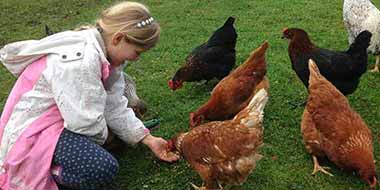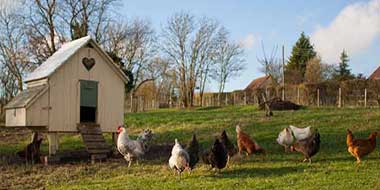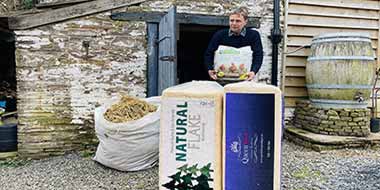
Equipment
Focus
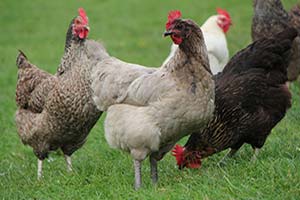
Although a chicken’s needs are fairly basic, getting the right kit can make life so much easier for the owner.
Choosing equipment for chickens from the vast variety of accessories can be difficult, but here, Anne lists the top ten items you will need to get started on your chicken-keeping journey.
1. Chicken feeder
What sort of feeder do you need?
Chickens are messy eaters and a well-designed feeder will keep food from being scattered around to become sour and attract vermin.
Cylinder feeders are widely available – choose one with a partitioned trough to keep waste to a minimum. A leak-proof ‘hat’ is essential for feeders that are placed outside to prevent feed from being ruined by rain.
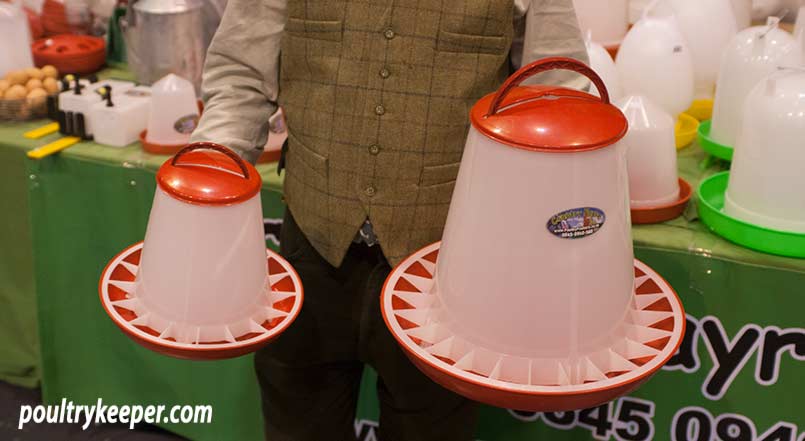
Raising the feeder helps keep the food free of debris. Some feeders have legs or can be hung up – otherwise you can buy a feeder stand or use a couple of bricks.
Metal or plastic?
Metal feeders are more expensive than plastic, but generally more robust. For the first-time keeper with a few hens, good-quality plastic is likely to be satisfactory – buying the cheapest is often false economy. Lightweight feeders are easily knocked over and damaged, while basic models sometimes don’t have sufficient space for the feed to flow easily into the trough.
What size feeder?
An average chicken gets through about 120-150 grams of food a day, but you should allow more than this amount per bird to ensure those lower down the pecking order get their fair share.
Select a size that will cater comfortably for your flock’s daily needs. Providing fresh food every day is preferable to filling a giant feeder to last the week.
For a larger flock, two feeders rather than one big one will help avoid squabbles over food.
2. Drinker
What sort of drinker do you need?
A proper drinker makes it easier to ensure your chickens always have essential clean water.
Choose a drinker that is straightforward to fill, especially if you intend to have several chickens. In most tower drinkers the central part is turned upside down for filling, then the base is re-attached and the drinker turned upright again. This can be tricky with a large drinker, but some types can be filled from the top.
Better designs of drinker feature a locking base – cheap plastic models usually have push-on bases. Not only are these messy to fill, but they can easily become blocked, resulting in thirsty chickens.
Like the feeder, the drinker should be positioned above ground level. Site it out of direct sunlight to prevent a build-up of poisonous algae and to keep the water cool.
Metal or plastic?
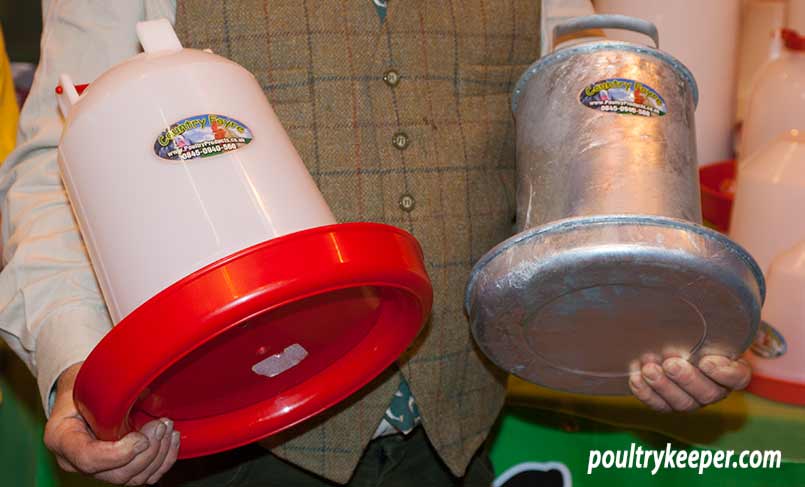
If intending to use Apple Cider Vinegar in the drinking water, choose a plastic drinker as a metal one will corrode.
Otherwise, metal is robust, long-lasting, and unlike plastic, won’t crack in freezing temperatures. Some metal drinkers have a glass top which helps when checking water levels.
What size drinker?
Chickens must always have access to fresh water during the day, and hens will stop laying if dehydrated.
Provide at least 500ml per bird, and check the drinker regularly in hot or freezing weather.
Remember when choosing equipment for chickens that a big container full of water will be heavy, so for a small person with a large flock, a couple of medium-sized drinkers may be more manageable!
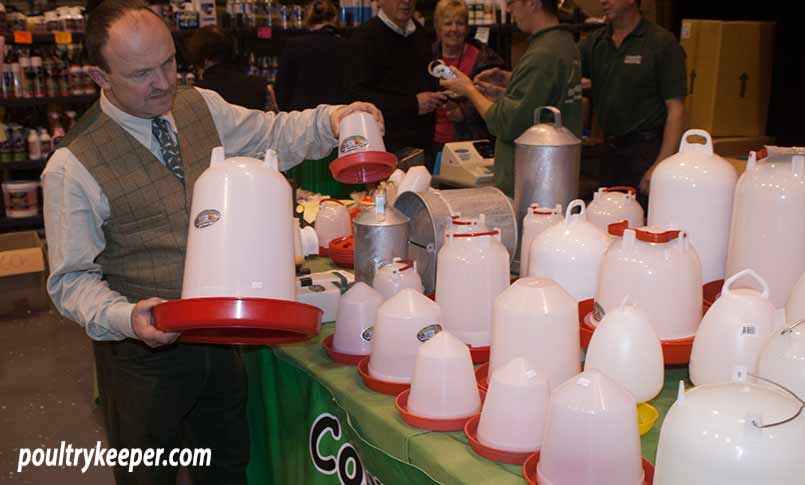
There are a number of different sized chicken drinkers available.
3. Feed storage bins
How to store your chicken feed
Dry, rodent-proof containers keep food in good condition and help avoid unwanted visitors. Galvanised storage bins are ideal, but a metal dustbin with a snugly fitting lid also works well. Plastic dustbins are cheaper, although rats have occasionally been known to chew through them. A spare container is useful for storing left-over feed overnight.; Always remove the feeder at night – there is no is no need to leave food and water in the henhouse, as chickens don’t eat or drink when they are roosting.
A feed scoop (or old cup) is useful for transferring food from bag to feeder.
4. Chicken feed
What type of chicken feed?
Modern feeds are formulated to provide a complete balanced diet for chickens – there are different feeds for laying hens, breeding stock, chicks, growers, etc.
Feed generally comes in pellets or mash – crumbs are also available for chicks and ex-battery hens.
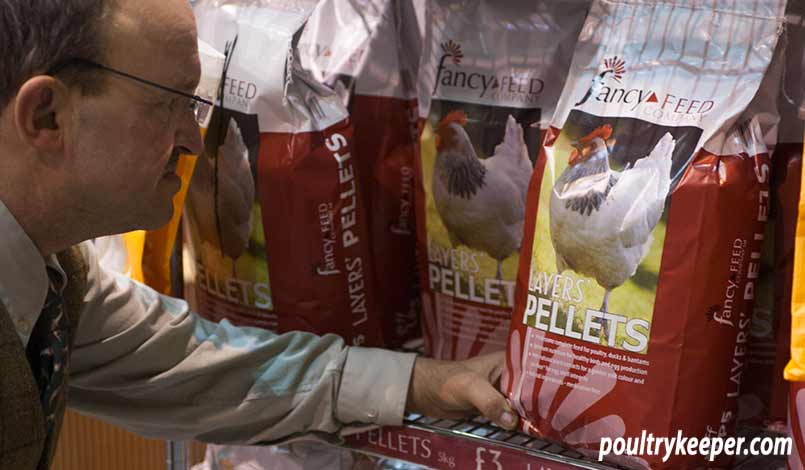
Pellets are easy and clean to feed, while mash can be given dampened or dry. Damp mash should be fed in a trough, quickly goes sour and must be removed if uneaten. Chickens take longer to eat dry mash than pellets, making it useful for keeping confined chickens occupied. It can be messy though, and is unsuitable for chickens with crests or facial feathering.
You will also see grain for chickens in the feed store – usually whole wheat or mixed corn. Chickens love grain, but it’s a heating food (useful in winter) and should be fed as a treat in the afternoon, when they’ve had time to fill up on their balanced rations.
Chicken feed has a shelf-life so check use-by dates. Aim to strike a balance between having enough feed in stock (especially during holiday periods), and keeping so much that it goes out of date before the chickens can eat it.
If you need to change your chickens’ feed, do so very gradually to avoid digestive upsets.
5. Grit
Soluble and Insoluble
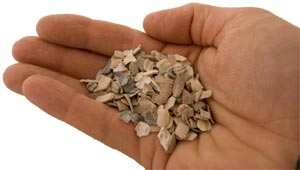
Soluble grit (shown here) is a calcium supplement which helps promote strong eggshells. Commercial feeds should contain enough calcium, but you can serve soluble grit in the same way as flint grit and the chickens will take what they need.
Mixed grit is a combination of the two types and handy to keep in stock.
6. The dust-bath
This is how chickens clean themselves
Free-range chickens will make their own arrangements, but confined chickens need a dust-bath so they can clean their skin and feathers.
A plastic box, washing-up bowl or sandpit tray could be used – almost anything that will hold some fine dry soil or soft sand. Don’t use a cardboard box though, as it will disintegrate and the chickens will eat it.
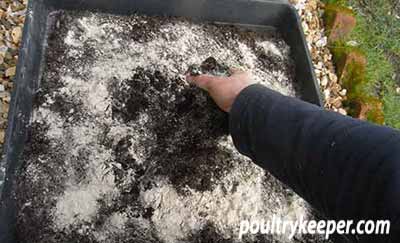
A dust bath containing some dry garden compost and diatom powder to help with mites.
7. Bedding material
What to put on the floor of the henhouse?
Chickens don’t sleep on their ‘bedding’ but the floor of the henhouse should be covered with a dust-free material to absorb moisture, add some insulation and make cleaning out easier.
Dust-extracted wood shavings are popular but there are several other options, including hemp (more absorbent) and even chopped cardboard. Large bales are more economical if you have space.
Tip: Straw & Hay
Straw can be used in nestboxes if it isn't dusty but compacts quickly on the floor. Hay can go mouldy and produce harmful spores, so it should be avoided. Dust extracted wood shavings are popular. Read more: Different bedding material for chickens

8. Cleaning-out kit
What you will need to clean out the chicken coop
The basics are a small shovel, a stiff brush and a bucket. A scraper helps to remove dried on droppings. Keep a washing-up brush by the garden tap for cleaning drinkers and feeders. Heavy-duty rubber gloves are useful when doing mucky jobs – and for dealing with grumpy broody hens!
You might also need:
Powder disinfectant (good for drying-up wet patches as well as combating infection).
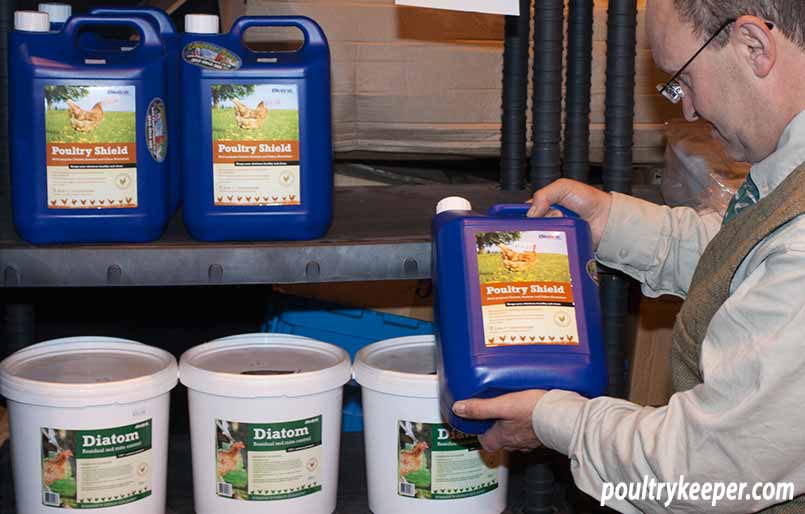
Poultry Shield is an effective cleaning agent that helps fight red mite
Diatom (diatomaceous earth) is a natural product that combats parasites – it can be used around the henhouse, on the chickens, and even added to feed
If the chickens are kept in a run, you’ll need ground sanitiser to help keep down disease.
9. Health and First Aid
Keeping on-top of parasites & being prepared for problems
As well as choosing equipment for chickens, we also need to think about medication as part of a first aid kit.
Chickens are host to several internal parasites, and worm test, followed by a worming programme, may be required to keep these under control. Advice is usually to check for worms, at least in spring and autumn, but your chickens may need more frequent checks depending on how they are kept – chickens in a static run are more challenged.
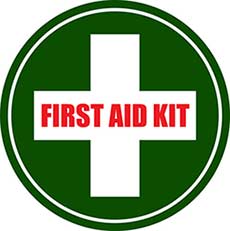 Flubenvet is a licensed (tested) wormer for chickens and is added to the feed. It should only be sold by a Suitably Qualified Person (SQP) and bought online (you should be asked to fill out a form), from some feed stores, or via the vet.
Flubenvet is a licensed (tested) wormer for chickens and is added to the feed. It should only be sold by a Suitably Qualified Person (SQP) and bought online (you should be asked to fill out a form), from some feed stores, or via the vet.
There are also natural methods of worming chickens with herbal products. These can help prevent worms from building up, although regular testing is still required to ensure it’s working.
To check your chickens for worms, buy a worm-egg count kit.
Getting A
Worm Count
Using a worm count kit is relatively straightforward. There are gloves, a collection bag for samples and a pre-paid envelope. The worm count takes place in a lab under a microscope and advice is returned by email advising you of the number of eggs and whether you need to worm your chickens.
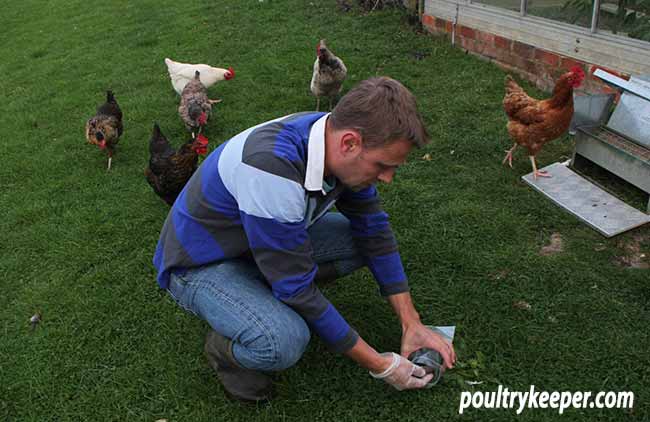
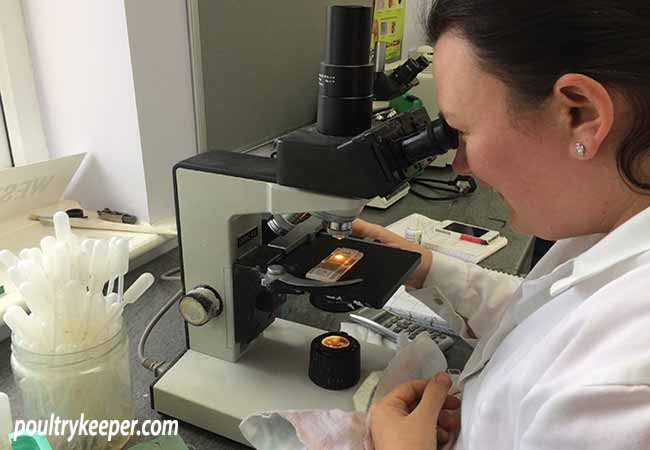
External parasites such as red mites can cause debility even death if allowed to get out of control. They multiply very quickly so you need to be ready for action at the first sign. Regular use of Poultry Shield and Diatom may be enough to keep them at bay, but having a mite treatment in stock is a sensible precaution.
First-Aid kit
Assemble a basic kit in a clean, labelled box ready for the emergency that will surely arrive at the most inconvenient time. There are many products available to treat all manner of ills, but to start with you could include the following:
- Antiseptic spray
- Poultry disinfectant (e.g. Virkon)
- Petroleum jelly
- Scissors
- Tweezers
- Eye-dropper or syringe
- Cotton wool, gauze pads, duct tape
- Bandage (Vetwrap is good as it doesn’t stick to hair or feathers)
- Disposable gloves
- A couple of small towels or flannels
Supplements can give your chickens a helpful boost, especially when they have undergone stress or sickness. One of the most useful is Apple Cider Vinegar, which helps support the immune and digestive systems – make sure you buy unpasteurised, preferably organic, vinegar. It is added to the drinking water (20ml vinegar to one litre water in a plastic drinker). Use it whenever necessary, or as a regular tonic for one week in each month.
Poultry Spice is another easily available supplement and is especially useful for helping chickens through the moult. Certainly one to consider when choosing equipment for chickens.
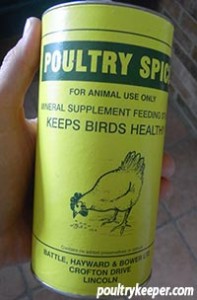
10. Entertainment
Keeping your chickens happy!
Free-range chickens keep themselves naturally busy. Chickens in a run with nothing to do but eat, preen and lay eggs can become bored and start bullying or feather-pecking each other. Prevention is much easier than curing these behaviours, so provide some logs or branches for them to perch on or hide behind.
Hang up some vegetables too, preferably, so the chickens have to jump a little to reach them – entertainment, exercise and vitamins in one go! This was a good tip from the keeping-chickens website feeding page!
Hopefully, you now have some good ideas on choosing equipment for chickens. There’s a lot more to help you learn how to keep chickens in our chickens section.

